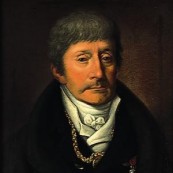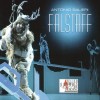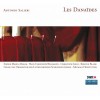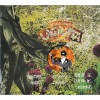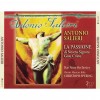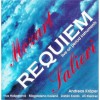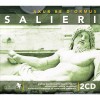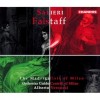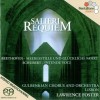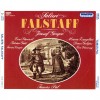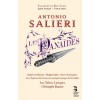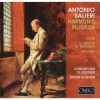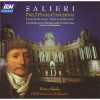Composers
Life
Born and raised in a prosperous family of merchants in Legnago, Salieri studied violin, and, with his parents, he moved to Padua, then to Venice, where he studied thoroughbass with Giovanni Battista Pescetti. There, he met Florian Leopold Gassmann in 1766, who invited him to attend the court of Vienna, and there trained him in composition based on Johann Joseph Fux's Gradus ad Parnassum. Salieri remained in Vienna for the rest of his life. In 1774, after Gassmann's death, Salieri was appointed court composer by Emperor Joseph II. He married Therese von Helferstorfer on 10 October 1774. The couple had eight children, only three of whom survived Salieri; his only son, Alois, died in 1805. Salieri became Royal and Imperial Kapellmeister in 1788, a post that he held till 1824. He was president of the "Tonkünstler-Societät" (society of musical artists) from 1788 to 1795, vice-president after 1795, and in charge of its concerts until 1818.
Salieri attained an elevated social standing and was frequently associated with other celebrated composers, such as Joseph Haydn and Louis Spohr. He played an important role in late 18th and early 19th century classical music. He was a teacher to many famous composers, including Ludwig van Beethoven, Carl Czerny, Johann Nepomuk Hummel, Franz Liszt, Giacomo Meyerbeer, Ignaz Moscheles, Franz Schubert, and Franz Xaver Süssmayr. He also taught Wolfgang Amadeus Mozart's younger son, Franz Xaver, some years after Mozart's death.
Salieri died in Vienna and was buried in the Matzleinsdorfer Friedhof (his remains were later transferred to the Zentralfriedhof). At his funeral service, his own Requiem in C minor - composed in 1804 - was performed for the first time. His monument is adorned by a poem written by Joseph Weigl, one of his pupils:
Rest in peace! Uncovered by dust
Eternity shall bloom for you.
Rest in peace! In eternal harmonies
Your spirit now is dissolved.
It expressed itself in enchanting notes,
Now it is floating to everlasting beauty.
Original German poem:
Ruh sanft! Vom Staub entblößt,
Wird Dir die Ewigkeit erblühen.
Ruh sanft! In ew’gen Harmonien
Ist nun Dein Geist gelöst.
Er sprach sich aus in zaubervollen Tönen,
Jetzt schwebt er hin zum unvergänglich Schönen.
Works
See List of compositions by Antonio Salieri and List of operas by Salieri.
During his time in Vienna, Salieri acquired great prestige as a composer and conductor, particularly of opera, but also of chamber and sacred music. The most successful of his more than forty operas included Europa riconosciuta (1778), Armida (1771), La scuola de' gelosi (1778), Der Rauchfangkehrer (1781), Les Danaïdes (1784), which was first presented as a work of Gluck's, Tarare (1787), Axur, Re d'Ormus (1788), Palmira, regina di Persia (1795), and Falstaff (1799). He wrote comparatively little instrumental music, however his limited output includes two piano concertos and a concerto for organ written in 1773, a concerto for flute, oboe and orchestra (1774), and a set of twenty-six variations on La follia di Spagna (1815).
Salieri and Mozart
In the 1780s while Mozart lived and worked in Vienna, he and his father Leopold wrote in their letters that several "cabals" of Italians led by Salieri were actively putting roadblocks in the way of Mozart's obtaining certain posts of staging his operas. There is a lot of evidence of Salieri's having engaged in such conspiratorial acts. At the beginning of the 19th century, increasing German nationalism led to a tendency to transfigure the Austrian Mozart's character, while the Venetian Salieri was given the role of his evil antagonist. As Mozart's music became more popular over the decades, Salieri's fame dropped. Carl Maria von Weber, a relative of Mozart by marriage whom Wagner has characterized as the most German of German composers, is said to have refused to join Ludlams-Höhle, a social club of which Salieri was a member and avoided having anything to do with him. These rumors then made their way into popular culture. Albert Lortzing's Singspiel Szenen aus Mozarts Leben LoWV28 (1832) uses the cliché of the jealous Salieri trying to hinder Mozart's career.
Ironically, Salieri's music was much more in the tradition of Gluck and Gassmann than of the Italians like Paisiello or Cimarosa. In 1772, Empress Maria Theresa commented on her preference of Italian composers over Germans like Gassmann, Salieri or Gluck. While Venetian by birth, Salieri had lived in imperial Vienna for almost 60 years and was regarded by such people as the music critic Friedrich Rochlitz as a German composer.
The biographer Alexander Wheelock Thayer believes that Mozart's suspicions of Salieri could have originated with an incident in 1781 when Mozart applied to be the music teacher of the Princess of Württemberg, and Salieri was selected instead because of his reputation as a singing teacher. In the following year Mozart once again failed to be selected as the Princess's piano teacher.
"Salieri and his tribe will move heaven and earth to put it down", Leopold Mozart wrote to his daughter Nannerl. But at the time of the premiere of Figaro, Salieri was busy with his new French opera Les Horaces.
In addition, when Lorenzo da Ponte was in Prague preparing the production of Mozart's setting of his Don Giovanni, the poet was ordered back to Vienna for a royal wedding for which Salieri's Axur, re d'Ormus would be performed. Obviously, Mozart was not pleased by this.
There is very little evidence of a contentious relationship between the two composers. For example, when Salieri was appointed Kapellmeister in 1788 he revived Figaro instead of bringing out a new opera of his own; and when he went to the coronation festivities for Leopold II in 1790 he had no fewer than three Mozart masses in his luggage. Salieri and Mozart even composed a cantata for voice and piano together, called Per la ricuperata salute di Ophelia which was celebrating the return to stage of the singer Nancy Storace. This work has been lost, although it had been printed by Artaria in 1785. Mozart's Davide penitente K.469 (1785), his piano concerto in E flat major K.482 (1785), the clarinet quintet K.581 (1789) and the great Symphony in G minor K.550 had been premiered on the suggestion of Salieri, who supposedly conducted a performance of it in 1791. In his last surviving letter from 14 October 1791, Mozart tells his wife that he collected Salieri and Caterina Cavalieri in his carriage and drove them both to the opera, and about Salieri's attendance at his opera Die Zauberflöte K 620, speaking enthusiastically: "He heard and saw with all his attention, and from the overture to the last choir there was no piece that didn't elicit a "Bravo!" or "Bello!" out of him."
Salieri's health declined in his later years, and he was hospitalized shortly before his death. It was shortly after he died that gossip first spread that he had confessed to Mozart's murder on his deathbed.[citation needed] Although Salieri's two nurses, Gottlieb Parsko and Georg Rosenberg, as well as his family doctor Joseph Röhrig, attested that he never said any such thing, this rumor is considered prevalent to this day.
Fictional treatments
* Within a few months of Salieri's death in 1825, Aleksandr Pushkin wrote his "little tragedy" Mozart and Salieri (1831) as a dramatic study of the sin of envy. Russian composer Nikolay Rimsky-Korsakov adapted Pushkin's play as an opera of the same name in 1898.
* A popular perpetuation of the story was in Peter Shaffer's play Amadeus (1979) and the Oscar-winning 1984 film directed by Miloš Forman based upon it. Salieri was portrayed in this film by F. Murray Abraham, who won the Academy Award for Best Actor. Salieri is characterized as both in awe of and insanely resentful towards Mozart, going so far as to renounce God for blessing his adversary. Salieri's later hospitalization is portrayed as a stay in a mental hospital, where he announces himself as "the Patron Saint of mediocrity".
* Salieri's supposed hatred for Mozart is also alluded to in a spoof opera entitled A Little Nightmare Music, by P.D.Q. Bach. In the opera, Salieri attempts to poison an anachronistic Shaffer but is bumped by a "clumsy oaf", which causes him to inadvertently poison Mozart instead and spill wine on his favorite coat.
* Patrick Stewart played Salieri in the 1985 production The Mozart Inquest.
Recent popularity
More and more of Salieri's music is being recorded. Many of his overtures and most of his limited symphonic music have now been released on CD, though Salieri wrote primarily for the voice and much of his operatic music is only starting to be recorded. In 2003, mezzo-soprano Cecilia Bartoli released The Salieri Album, a CD with 13 arias from Salieri's operas, most of which had never been recorded before. Patrice Michaels sang a number of his arias on the CD Divas of Mozart's Day. In 2008, another female opera star, Diana Damrau, released a CD with seven Salieri coloratura arias. Since 2000, there have also been complete recordings issued or re-issued of the operas Axur Re d'Ormus, Falstaff, Les Danaïdes, La Locandiera, La grotta di Trofonio and Prima la musica e poi le parole. Salieri has yet to fully re-enter the general repertory, but performances of his works are progressively becoming more regular.
His operas Falstaff (1995 production) and Tarare (1987 production) have been released on DVD. In 2004, the opera Europa Riconosciuta was staged in Milan for the reopening of La Scala in Milan, with soprano Diana Damrau in the title role. This production was also broadcast on television, with a future DVD release possible.
Salieri has even begun to attract some attention from Hollywood. In 2001, his triple concerto was used in the soundtrack of The Last Castle, featuring Robert Redford and James Gandolfini. It is a story that builds on the rivalry between a meticulous but untested officer (Gandolfini) serving as the warden of a military prison and an imprisoned but much admired and highly decorated general (Redford). The Salieri piece is used as the warden's theme music, seemingly to invoke the image of jealousy of the inferior for his superior. In 2006, the movie Copying Beethoven referred to Salieri in a more positive light. In this movie a young female music student hired by Beethoven to copy out his Ninth Symphony is staying at a monastery. The abbess tries to discourage her from working with the irreverent Beethoven. She notes that she too once had dreams, having come to Vienna to study opera singing with Salieri. Most recently the 2008 movie Iron Man used the Larghetto movement from Salieri's Piano Concerto In C Major. The scene where Obadiah Stane, the archrival of 'Tony' Stark, the wealthy industrialist turned Ironman, tells Tony that he is being ousted from his company by the board, Obadiah plays the opening few bars of the Salieri concerto on a piano in Stark's suite.
Recently Added
Biography
Life
Born and raised in a prosperous family of merchants in Legnago, Salieri studied violin, and, with his parents, he moved to Padua, then to Venice, where he studied thoroughbass with Giovanni Battista Pescetti. There, he met Florian Leopold Gassmann in 1766, who invited him to attend the court of Vienna, and there trained him in composition based on Johann Joseph Fux's Gradus ad Parnassum. Salieri remained in Vienna for the rest of his life. In 1774, after Gassmann's death, Salieri was appointed court composer by Emperor Joseph II. He married Therese von Helferstorfer on 10 October 1774. The couple had eight children, only three of whom survived Salieri; his only son, Alois, died in 1805. Salieri became Royal and Imperial Kapellmeister in 1788, a post that he held till 1824. He was president of the "Tonkünstler-Societät" (society of musical artists) from 1788 to 1795, vice-president after 1795, and in charge of its concerts until 1818.
Salieri attained an elevated social standing and was frequently associated with other celebrated composers, such as Joseph Haydn and Louis Spohr. He played an important role in late 18th and early 19th century classical music. He was a teacher to many famous composers, including Ludwig van Beethoven, Carl Czerny, Johann Nepomuk Hummel, Franz Liszt, Giacomo Meyerbeer, Ignaz Moscheles, Franz Schubert, and Franz Xaver Süssmayr. He also taught Wolfgang Amadeus Mozart's younger son, Franz Xaver, some years after Mozart's death.
Salieri died in Vienna and was buried in the Matzleinsdorfer Friedhof (his remains were later transferred to the Zentralfriedhof). At his funeral service, his own Requiem in C minor - composed in 1804 - was performed for the first time. His monument is adorned by a poem written by Joseph Weigl, one of his pupils:
Rest in peace! Uncovered by dust
Eternity shall bloom for you.
Rest in peace! In eternal harmonies
Your spirit now is dissolved.
It expressed itself in enchanting notes,
Now it is floating to everlasting beauty.
Original German poem:
Ruh sanft! Vom Staub entblößt,
Wird Dir die Ewigkeit erblühen.
Ruh sanft! In ew’gen Harmonien
Ist nun Dein Geist gelöst.
Er sprach sich aus in zaubervollen Tönen,
Jetzt schwebt er hin zum unvergänglich Schönen.
Works
See List of compositions by Antonio Salieri and List of operas by Salieri.
During his time in Vienna, Salieri acquired great prestige as a composer and conductor, particularly of opera, but also of chamber and sacred music. The most successful of his more than forty operas included Europa riconosciuta (1778), Armida (1771), La scuola de' gelosi (1778), Der Rauchfangkehrer (1781), Les Danaïdes (1784), which was first presented as a work of Gluck's, Tarare (1787), Axur, Re d'Ormus (1788), Palmira, regina di Persia (1795), and Falstaff (1799). He wrote comparatively little instrumental music, however his limited output includes two piano concertos and a concerto for organ written in 1773, a concerto for flute, oboe and orchestra (1774), and a set of twenty-six variations on La follia di Spagna (1815).
Salieri and Mozart
In the 1780s while Mozart lived and worked in Vienna, he and his father Leopold wrote in their letters that several "cabals" of Italians led by Salieri were actively putting roadblocks in the way of Mozart's obtaining certain posts of staging his operas. There is a lot of evidence of Salieri's having engaged in such conspiratorial acts. At the beginning of the 19th century, increasing German nationalism led to a tendency to transfigure the Austrian Mozart's character, while the Venetian Salieri was given the role of his evil antagonist. As Mozart's music became more popular over the decades, Salieri's fame dropped. Carl Maria von Weber, a relative of Mozart by marriage whom Wagner has characterized as the most German of German composers, is said to have refused to join Ludlams-Höhle, a social club of which Salieri was a member and avoided having anything to do with him. These rumors then made their way into popular culture. Albert Lortzing's Singspiel Szenen aus Mozarts Leben LoWV28 (1832) uses the cliché of the jealous Salieri trying to hinder Mozart's career.
Ironically, Salieri's music was much more in the tradition of Gluck and Gassmann than of the Italians like Paisiello or Cimarosa. In 1772, Empress Maria Theresa commented on her preference of Italian composers over Germans like Gassmann, Salieri or Gluck. While Venetian by birth, Salieri had lived in imperial Vienna for almost 60 years and was regarded by such people as the music critic Friedrich Rochlitz as a German composer.
The biographer Alexander Wheelock Thayer believes that Mozart's suspicions of Salieri could have originated with an incident in 1781 when Mozart applied to be the music teacher of the Princess of Württemberg, and Salieri was selected instead because of his reputation as a singing teacher. In the following year Mozart once again failed to be selected as the Princess's piano teacher.
"Salieri and his tribe will move heaven and earth to put it down", Leopold Mozart wrote to his daughter Nannerl. But at the time of the premiere of Figaro, Salieri was busy with his new French opera Les Horaces.
In addition, when Lorenzo da Ponte was in Prague preparing the production of Mozart's setting of his Don Giovanni, the poet was ordered back to Vienna for a royal wedding for which Salieri's Axur, re d'Ormus would be performed. Obviously, Mozart was not pleased by this.
There is very little evidence of a contentious relationship between the two composers. For example, when Salieri was appointed Kapellmeister in 1788 he revived Figaro instead of bringing out a new opera of his own; and when he went to the coronation festivities for Leopold II in 1790 he had no fewer than three Mozart masses in his luggage. Salieri and Mozart even composed a cantata for voice and piano together, called Per la ricuperata salute di Ophelia which was celebrating the return to stage of the singer Nancy Storace. This work has been lost, although it had been printed by Artaria in 1785. Mozart's Davide penitente K.469 (1785), his piano concerto in E flat major K.482 (1785), the clarinet quintet K.581 (1789) and the great Symphony in G minor K.550 had been premiered on the suggestion of Salieri, who supposedly conducted a performance of it in 1791. In his last surviving letter from 14 October 1791, Mozart tells his wife that he collected Salieri and Caterina Cavalieri in his carriage and drove them both to the opera, and about Salieri's attendance at his opera Die Zauberflöte K 620, speaking enthusiastically: "He heard and saw with all his attention, and from the overture to the last choir there was no piece that didn't elicit a "Bravo!" or "Bello!" out of him."
Salieri's health declined in his later years, and he was hospitalized shortly before his death. It was shortly after he died that gossip first spread that he had confessed to Mozart's murder on his deathbed.[citation needed] Although Salieri's two nurses, Gottlieb Parsko and Georg Rosenberg, as well as his family doctor Joseph Röhrig, attested that he never said any such thing, this rumor is considered prevalent to this day.
Fictional treatments
* Within a few months of Salieri's death in 1825, Aleksandr Pushkin wrote his "little tragedy" Mozart and Salieri (1831) as a dramatic study of the sin of envy. Russian composer Nikolay Rimsky-Korsakov adapted Pushkin's play as an opera of the same name in 1898.
* A popular perpetuation of the story was in Peter Shaffer's play Amadeus (1979) and the Oscar-winning 1984 film directed by Miloš Forman based upon it. Salieri was portrayed in this film by F. Murray Abraham, who won the Academy Award for Best Actor. Salieri is characterized as both in awe of and insanely resentful towards Mozart, going so far as to renounce God for blessing his adversary. Salieri's later hospitalization is portrayed as a stay in a mental hospital, where he announces himself as "the Patron Saint of mediocrity".
* Salieri's supposed hatred for Mozart is also alluded to in a spoof opera entitled A Little Nightmare Music, by P.D.Q. Bach. In the opera, Salieri attempts to poison an anachronistic Shaffer but is bumped by a "clumsy oaf", which causes him to inadvertently poison Mozart instead and spill wine on his favorite coat.
* Patrick Stewart played Salieri in the 1985 production The Mozart Inquest.
Recent popularity
More and more of Salieri's music is being recorded. Many of his overtures and most of his limited symphonic music have now been released on CD, though Salieri wrote primarily for the voice and much of his operatic music is only starting to be recorded. In 2003, mezzo-soprano Cecilia Bartoli released The Salieri Album, a CD with 13 arias from Salieri's operas, most of which had never been recorded before. Patrice Michaels sang a number of his arias on the CD Divas of Mozart's Day. In 2008, another female opera star, Diana Damrau, released a CD with seven Salieri coloratura arias. Since 2000, there have also been complete recordings issued or re-issued of the operas Axur Re d'Ormus, Falstaff, Les Danaïdes, La Locandiera, La grotta di Trofonio and Prima la musica e poi le parole. Salieri has yet to fully re-enter the general repertory, but performances of his works are progressively becoming more regular.
His operas Falstaff (1995 production) and Tarare (1987 production) have been released on DVD. In 2004, the opera Europa Riconosciuta was staged in Milan for the reopening of La Scala in Milan, with soprano Diana Damrau in the title role. This production was also broadcast on television, with a future DVD release possible.
Salieri has even begun to attract some attention from Hollywood. In 2001, his triple concerto was used in the soundtrack of The Last Castle, featuring Robert Redford and James Gandolfini. It is a story that builds on the rivalry between a meticulous but untested officer (Gandolfini) serving as the warden of a military prison and an imprisoned but much admired and highly decorated general (Redford). The Salieri piece is used as the warden's theme music, seemingly to invoke the image of jealousy of the inferior for his superior. In 2006, the movie Copying Beethoven referred to Salieri in a more positive light. In this movie a young female music student hired by Beethoven to copy out his Ninth Symphony is staying at a monastery. The abbess tries to discourage her from working with the irreverent Beethoven. She notes that she too once had dreams, having come to Vienna to study opera singing with Salieri. Most recently the 2008 movie Iron Man used the Larghetto movement from Salieri's Piano Concerto In C Major. The scene where Obadiah Stane, the archrival of 'Tony' Stark, the wealthy industrialist turned Ironman, tells Tony that he is being ousted from his company by the board, Obadiah plays the opening few bars of the Salieri concerto on a piano in Stark's suite.
